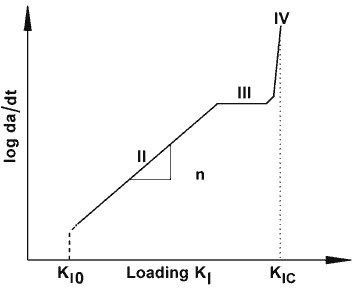5.3.3.5 Stress
Intensity Factor
Ceramic materials are subject to brittle
fracture. Ductile deformation, as observed in metals, is possible
only at temperatures close to the softening temperature. The
stress intensity factor KI has been adopted
from fracture mechanics in order to determine the behaviour
of brittle materials with respect to crack growth.
The critical stress intensity factor, KIC
[MPa* m]
is a measure of the susceptibility to cracking or the brittleness
of the material (crack resistance). Crack growth behaviour
is not dependent on loading alone, but on a combination of
loading and crack size. Failure occurs when the critical value
KIC is reached. m]
is a measure of the susceptibility to cracking or the brittleness
of the material (crack resistance). Crack growth behaviour
is not dependent on loading alone, but on a combination of
loading and crack size. Failure occurs when the critical value
KIC is reached.
KIC is essentially the product of stress perpendicular to
the plane of a crack caused by outside forces,  ,
and the square root of the length of the most dangerous crack,
a. Furthermore, there is also a dependency on the geometry
of the part and that of the crack and therefore on a correction
factor, Y. ,
and the square root of the length of the most dangerous crack,
a. Furthermore, there is also a dependency on the geometry
of the part and that of the crack and therefore on a correction
factor, Y.

Simply put, materials with a high KIC value
(for example, SN or zirconium oxide PZT  KIC = up to 10.5) have a high resistance to crack propagation.
KIC = up to 10.5) have a high resistance to crack propagation.

Figure 86: Scematic crack growth diagram for technical
ceramics
|
|

